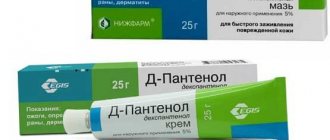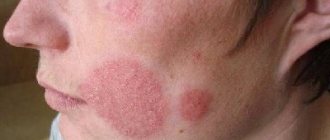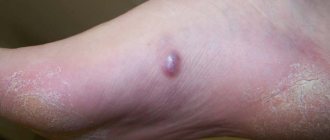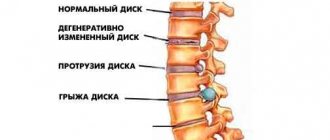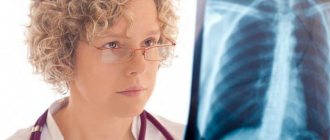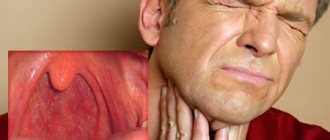Category: Diseases
Today on alter-zdrav.ru we will talk about a common skin disease - erysipelas, its symptoms, causes of the disease, diagnosis, forms, types of pathology and of course, treatment, recommended diet, folk methods of combating erysipelas at home.
Skin is not only an elastic tissue that performs the function of touch, exchange of gases and substances, thermoregulation, but also protects the human body from various undesirable factors and the penetration of pathogens.
But when certain reasons occur, the skin becomes a target for harmful bacteria and a reason for a person to consult a dermatologist.
What is erysipelas (erysipelas)
Erysipelas is an inflammatory process of the skin or mucous membranes of an infectious nature, localized throughout the body, but more often on the face or lower leg. The disease is quite common and ranks 4th among such popular infections as respiratory diseases, hepatitis and intestinal inflammation.
Erysipelas can be diagnosed in any person, but able-bodied men and women over 45 years of age are more susceptible. The risk zone includes the population occupying work positions and receiving microtraumas during the course of work. According to statistical data over the past 20 years, erysipelas has become more common, recurrent cases are increasing by 20-25% and the severity of such diseases is increasing by 8-10%.
The causative agent of erysipelas is streptococcus. It gets on the skin through close contact with a sick person, using his personal belongings, sexual intercourse, or eating food that has been touched by an infected person.
Also, the pathogen easily penetrates through the placenta to the fetus through a transfusion of infected blood or insufficiently sterilized instruments for manicure, injections or any medical procedures.
If a person’s immunity is strong enough, then streptococcus settles on the skin among bacteria and does not reveal its presence for a long time. But, unfortunately, the carrier is dangerous to others. When the defenses are weakened or injured, the pathogen penetrates the skin and causes various changes, leading to severe suffering.
Who is susceptible to the disease
According to doctors, people susceptible to the disease can be divided into 3 categories:
- Women over 50 years of age and older.
- Men whose profession involves heavy physical labor, such as military service, construction, or industrial work.
- People who are close to the infected person.
Figure No. 2. Erysipelas in women
A separate category includes people with specific diseases in acute or chronic form, for example:
- Diabetes;
- HIV;
- Oncological diseases;
- People taking cytostatics or drugs based on corticosteroids.
However, if you do not fall into any of these categories, this does not mean that you cannot get erysipeloid.
Action of the pathogen
- Cell destruction.
- Decreased immunity.
- Quickly penetrates healthy cells due to the destruction of hyaluronic acid.
- Triggers the active production of cytokines - substances that cause inflammation.
- It drives the immune system crazy and causes it to mistake blood vessels for foreign bodies.
- Streptococcus settles in the lymphatic vessels and produces toxins from there. The human immune system is not always able to remember its DNA and attack at the beginning of an infection. This occurs due to the rapid and uncontrolled variability of the bacterium.
Prevention
Erysipelas is a rather serious disease with serious consequences and complications. It should also be taken into account that a seemingly cured disease can simply leave the surface of the skin and settle somewhere in the body, waiting for its “finest” hour. Therefore, a healthy person needs to focus on preventing disease. By the way, by taking precautions against contracting such inflammation, you simultaneously protect yourself from other viral infections, such as the flu.
Even from our school days, we remember that cleanliness is the key to health. Cleanliness of body, clothes, cutlery. In this case – cleanliness and proper foot care. Any hypothermia, cut, crack, or open wound can serve as a “gateway” for bacteria to the body.
It is more difficult to protect yourself from infection for those suffering from:
- diabetes mellitus;
- immunodeficiency syndrome;
- allergies;
- varicose veins;
- · disruption of the cardiovascular system;
- digestive tract.
Even a black dot of caries on the teeth will help streptococci develop vigorous negative activity. For people with a weakened immune system, it is especially important to pay attention to the prevention of erysipelas on the leg in the initial stage.
Complications
Late treatment or its incomplete process can lead to swelling of the lymph of varying degrees, disruption of the blood vessels, heart, sepsis, abscesses, inflammation of the walls of the veins, and elephantiasis of the lower extremities. Particularly neglected erysipelas threatens skin death. (How to cure if she has a mug on her leg)
Causes of erysipelas
- Professional factor - chemicals, injuries, burns, calluses, frequent wearing of rubber shoes.
- Viral diseases - lichen, herpes.
- Dermatological diseases (urticaria, dermatitis, ulcers, boils) and skin scarring.
- Pathologies of the eyes or nasal cavity - sinusitis, rhinitis, conjunctivitis, large tonsils.
- Diseases of the circulatory system - high cholesterol, anemia, thrombophlebitis.
- Cancerous tumors.
- HIV AIDS.
- Pathologies of the endocrine system.
- Oral diseases – caries, periodontitis.
- Regularly wearing clothing and shoes that impede natural blood flow.
- Festering of bedsores, wounds, syringe or catheter insertion sites.
- Excessive tanning or frequent exposure of skin to cold temperatures.
- Scratching, insect bites, splinters.
- Stress.
- Cracked heels.
- Toenail fungus.
- Excessive alcohol consumption.
These and many conditions significantly reduce immunity, increase the risk of staphylococcus penetration and create a favorable environment for its life and development.
Symptoms of erysipelas of the leg
The disease begins acutely approximately 6-10 days after penetration of the bacterium and is manifested by severe intoxication. Possible apathetic state, sudden weakness, loss of strength. Body temperature often reaches 40 degrees and is accompanied by fever and chills.
The patient suffers from headaches and joint pain, attacks of nausea and vomiting. A person loses the ability to sleep normally. In severe cases, loss of consciousness and delirium occur.
Hyperemia
The affected area of the skin acquires a bright red uniform color. This occurs within 24 hours of the onset of infection and is due to the destruction of red blood cells and dilation of blood vessels.
A characteristic phenomenon is the loss of color brightness when pressing with a finger on the area of hyperemia. After a couple of seconds the redness returns. Redness lasts for an average of 2 weeks and then gives way to peeling. This symptom occurs due to the rejection of dead skin cells.
"Tongues of Flame"
The inflamed area of skin does not have smooth boundaries. They resemble the outline of a map or fire. This is observed due to the capture of healthy epidermal cells by bacteria. Streptococcus multiplies quickly and infects new territories.
Demarcation roller
This is a compacted area of skin located along the entire perimeter of the lesion, bordering on a healthy surface. In the thickness of the cushion, bacteria are much more active than in the center of inflammation. Along the perimeter, a person feels severe pain, swelling and heat.
Burning and soreness
These symptoms include swelling, tension, discomfort, and a feeling of pressure. Toward the edge of the lesion, all these symptoms intensify. Upon palpation, the feeling of pain increases. This occurs due to the irritating effect of toxins on nerve endings and swelling of the epidermis.
Diagnostics
The development of erysipelas can be assumed based on an initial examination and questioning of the patient. In the absence of concomitant diseases, the diagnosis can be confirmed using a routine general blood test, where changes in the following indicators are observed:
- Rapid increase in ESR. Normalization of indicators occurs only 3 weeks after treatment.
- Decrease in the number of leukocytes. This result indicates that the immune system is suppressed by the infection.
- Decreased levels of red blood cells and hemoglobin.
Lymphangitis
These are stripes on the body that follow the trail of enlarged lymph nodes. If this symptom appears during the height of erysipelas, then in most cases the patient will experience a quick relapse.
Enlarged lymph nodes
Most often this occurs with subcutaneous and inguinal nodes. They are painful and fused to the skin. This is observed due to the fact that streptococcus multiplies in the lymphatic vessels. With the lymph flow, bacteria enter the lymph nodes. Their cells “capture” the bacterium and begin working to destroy it.
A painful limb deprives a person of a full life, appetite and sleep are disrupted, and movements are limited.
Forms of erysipelas
- The erythematous form is characterized by the appearance of a bright focus with clear boundaries.
- Hemorrhagic is caused by hemorrhages into the inflammatory focus.
- In the bullous form, blisters form, filled with liquid with a very high content of staphylococcus.
- Bullous-hemorrhagic is explained by the formation of bloody blisters with a cloudy reddish liquid.
- In the gangrenous form, areas of rotting and necrosis appear on the inflammatory focus. Gangrenous is also called wandering, as it gradually spreads to healthy tissue.
Complications
After treatment of erysipelas, relapses may occur. Recurrence of the disease can lead to the following complications:
- stagnation of lymph and insufficiency of lymph circulation (lymphedema, elephantiasis, lymphorrhea);
- pneumonia;
- ulcers, ulcers, abscesses, phlegmons;
- sepsis;
- skin death (necrosis);
- thrombophlebitis.
Figure No. 8. Erysipelas, lymphostasis, leg swelling
When blood and lymph circulation in the lesion is impaired, patients develop warts and the skin thickens in certain areas (hyperkeratosis). There are developments of eczema. At the site of the inflamed area there may be persistent skin pigmentation.
Flow degrees
- Mild type of erysipelas. At the same time, the body temperature does not rise above 38.5 degrees, the focus of inflammation is not large.
- The average degree is characterized by a temperature of about 40 degrees, lasting up to 5 days. There may be several lesions.
- Heavy current. Often this is a gangrenous or bullous-hemorrhagic form. The patient's condition is critical, temperature is above 40 degrees, delirium.
Treatment of erysipelas
In most cases, treatment takes place on an outpatient basis. Hospitalization is indicated if the patient does not have a separate room, there are small children at home, and the infection is severe.
At the first symptoms, you should immediately consult a dermatologist. This will avoid such serious consequences as rheumatism, elephantiasis, abscess, trophic ulcers, myocarditis and much more.
Drug treatment
- Antibiotics. Erythromycin, oleanodomycin, ospamox.
- Intestinal bacteria. Linex, Hilak-Forte.
- Vitamins of group B, A, C and others.
- Detoxification. Reopolyglucin, glucose.
- Anti-inflammatory. Reopirin, diclofenac.
- Painkillers, antipyretics. Nurofen.
- Diuretics. Hypothiazide.
- Antihistamines. Claritin.
- Immunity support products. Prodigiozan.
- Ointments, lotions, and powders are applied topically, depending on the need. Iruksol, furatsilin.
- Physiotherapy, ultraviolet, electrophoresis, magnetic therapy, applications with ozokerite.
- Laser therapy.
Surgery
Surgical intervention is indicated in cases of severe disease, complications and frequent relapses. During the operation, the surgeon opens each bubble, cleans the resulting cavity, rinses it with an antiseptic solution and applies an antibacterial ointment.
Erysipelas - treatment with folk remedies at home
Alternative medicine has a positive effect in the treatment of erysipelas, but its use is permissible only for mild cases of the disease and after consultation with the attending physician. If the condition worsens, such treatment should be stopped and urgently seek help from a medical facility.
- 100 g of burnet is poured. boil the water for 10 minutes. After the broth has cooled to room temperature, a tampon is moistened in it and applied to the site of inflammation. This relieves swelling and itching.
- Crush the chalk and sprinkle it on the erysipelas. Wrap the area of inflammation with a red cloth and bandage. This dressing is done at night. Over time, the pain and hyperemia will go away.
- Grind cabbage or celery into a semi-liquid porridge. Apply to the painful area for 30 minutes.
Diet
In the first few days, a sick person is allowed only boiled, cooled water or orange juice.
After normalizing the temperature, the diet includes foods such as apples, peaches, oranges, carrots, apricots, pears, honey, milk, green tea, beans, dried apricots, peanuts, almonds, potatoes, seaweed, oatmeal, cottage cheese, lean meat and seafood , sorrel leaves, raspberries, cherries.
Smoked meats and sausages, caffeine-containing drinks and dishes, alcohol, spicy, salty foods, and bread are prohibited.
Signs
Before clinical symptoms appear to aid diagnosis, a person may experience the following problems:
- Severe headaches;
- Muscle pain;
- General loss of strength;
- Nausea;
- Vomit;
- Poor absorption of consumed food;
- A sharp increase in temperature to maximum levels;
- In rare cases, convulsions, fainting and even hallucinations are observed.
Figure No. 6. Erysipelas of the finger
After about a day, clinical symptoms begin to appear:
- The affected area hurts, a strong burning sensation is felt;
- The skin swells, persistent hyperemia (redness) is noticeable;
- The damaged area of the skin “pulls” and tenses;
- The blood pulsates noticeably in the leg, the temperature rises noticeably (relative to other parts of the body).
Further symptoms depend on the form of the disease, and may include blisters, crusting, or bruising.
Figure No. 7. Erysipelas of the leg

